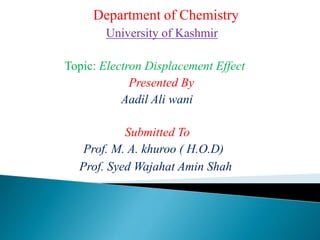
Electron Displacement Effect
- 1. Department of Chemistry University of Kashmir Topic: Electron Displacement Effect Presented By Aadil Ali wani Submitted To Prof. M. A. khuroo ( H.O.D) Prof. Syed Wajahat Amin Shah
- 2. Electron Displacement Effect Displacement of electron pair in the covalent bonds can results in two types of polarizations ,permanent polarization and temporary polarization. Permanent Polarizations:-Occurs in the ground state under the influence of an atom or a substituent group , e.g.; Inductive effect , Mesomeric effect and Hyperconjugation . Temporary Polarization:-occurs in presence of an attacking reagent, e.g.; Electromeric effect.
- 3. Inductive Effect 1. it refers to the polarity produced in a molecule as a result of higher electronegativity of one atom compared to another. e.g. CHꝫᵟᵟ⁺―CH₂ᵟ⁺―Clᵟ⁻ 1. polarization of σ-bond results in partial charge over adjacent atoms and is transmitted along a chain. 1. occurs in σ-bonds only formed between atoms of different electronegativity. 2. electron cloud is displaced towards more electronegative atom . 3. C―H bond is used as standard ,zero effect is assumed in this case. 4. It is of two types;+I effect and –I effect .
- 4. -I Effect:-occurs when atoms or group of atoms having more electron attracting capacity than H-atom (e-withdrawing group) is attached to a molecule , e.g. NO₂ ,COOH ,Cl ,Br, etc. ―Cᵟ⁺―Clᵟ⁻ +I Effect:-occurs when atoms or group of atoms having less electron attracting capacity than H-atom (e-releasing group) is attached to an organic molecule ,e.g. (CH₃)₃C- , (CH₃)₂CH-, CH₃CH₂- , CH₃-. CH₃ᵟ⁺―NH₂ᵟ⁻
- 5. Applications of Inductive Effect:-it explains the relative stability of Carbocation's ; stability increases with increase in the no of alkyl groups . E.g. Carbanions ; stability decreases with increase in the no of alkyl groups.eg; Acidic strength ; Electron withdrawing group decreases the negative charge on the carboxylate ion by stabilizing it ,hence the acidic strength increases ,e.g. CF₃COOH>CHF₂COOH>CH₂FCOOH>CH₃COOH
- 6. Mesomeric Effect There are many molecules whose structure can not be explained by a single Lewis structure. To explain their behavior two or more structures may be proposed and the actual molecule is said to be resonance hybrid of these molecules. It refers to the polarity produced in a molecule as a result of interaction between two π-bonds or a π-bond and a lone pair of electrons. It involves π-electrons of double or a triple bond. It can be divided into two types ,+M effect & -M effect.
- 7. +M effect:-atoms or groups of atoms which lose electrons towards a carbon atom are said to have +M effect, e.g. NH₂, Cl, Br, I, OH, etc. -M effect:-atoms or groups of atoms which draw electrons away from the carbon atom are said to have –M effect , e.g. NO₂, C≡N, C=O, etc.
- 8. Rules for resonance Only pi-electrons or non bonding electrons are involved. Energy of resonance hybrid should be lower than contributing structures. Structure should be planar . No of paired or unpaired electrons should be same. Contributing structures have nearly same energy. Stability of resonating structures More the no. of covalent bonds more stable the structure is . Structure with complete octet are more stable. Negative charge should be on more electronegative atom. Like charges should not be on adjacent positions.
- 9. Electromeric Effect It refers to the polarity produced in a multiple bonded compound as it is approached by a reagent. The presence of reagent disturbs the symmetry of pi-molecular orbitals in favor of one of the carbon atoms. It is a temporary effect. It is classified as, +E, and –E effect. +E effect:-when the transfer of electrons takes place towards the attacking reagent is called +E effect. e.g. -E effect :-when transfer of electron takes place away from the attacking reagent it is called –E effect, e.g.
- 10. Hyperconjugation Refers to the displacement of electrons through delocalization of σ-electrons from α- C-H bond with the π- electrons (π-orbitals) of the adjacent multiple bond or to an atom with p-orbital is called hyperconjugation or no bond resonance. The relative stability of various carbocation's can be explained by no bond resonance structures that can be written for them . Such structures are arrived at the shifting the bonding electrons from adjacent C-H bond to the electron deficient carbon. In this way the positive charge originally on carbon is dispersed to the hydrogen. Greater the no of alkyl groups attached to a positively charged C- atom greater is the hyperconjugation interaction & more stable the carbocation is, thus, 3˚>2˚>1˚>CH₃⁺ The total no of possible canonical structures is (n+1).
- 11. Such structures are arrived at the shifting the bonding electrons from adjacent C-H bond to the electron deficient carbon.
- 12. In carbocation's positive charge remains same in all the canonical structures including the hyperconjugative one is called Isovalent hyperconjugation. In case of alkenes more substituted alkenes are relatively more stable than unsubstituted alkenes , thus; (CH₃)₂C=C(CH₃)₂ > CH₃CH=CHCH₃ > CH₃CH=CH > CH₂=CH₂
- 13. Hyperconjugation in alkenes results from donation of electron density from an adjacent σ-bond to π- antibonding orbital. e.g.
- 14. In alkenes there is one less real bond in the canonical structures than the hyperconjugative structure, also there is no real separation of charge as H⁺.This is termed as Sacrificial Hyperconjugation. It results in shortening of C-C bonds adjacent to multiple bonds. Stability of free radicals ; greater the no. of alkyl groups attached to a free radical more stable it is , thus; i
- 15. In case of α-Halo alkenes the delocalization of electrons occurs towards the halogen group through the hyperconjugative mechanism, it is referred to as Reverse Hyperconjugation.
- 16. Thanks To All OF You
